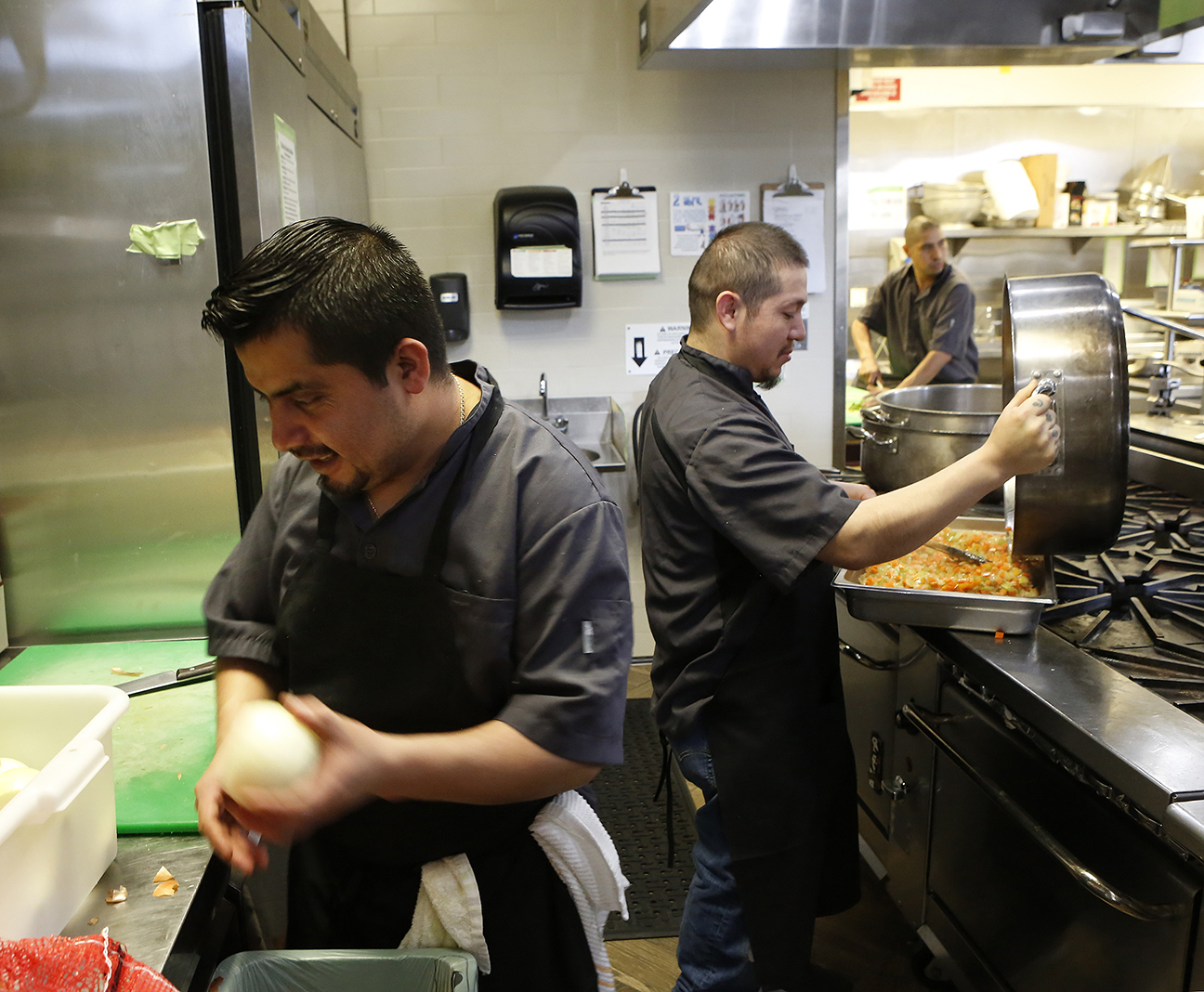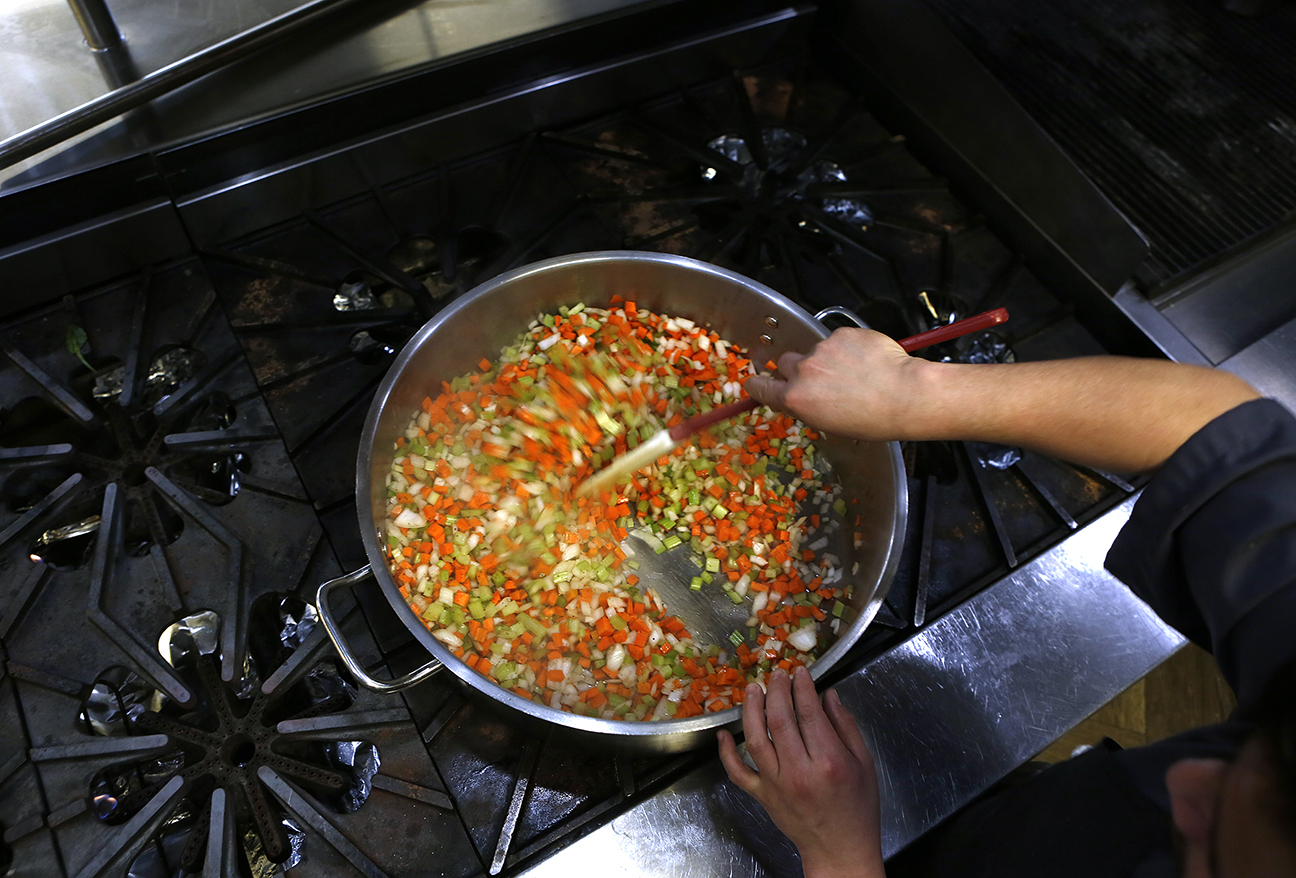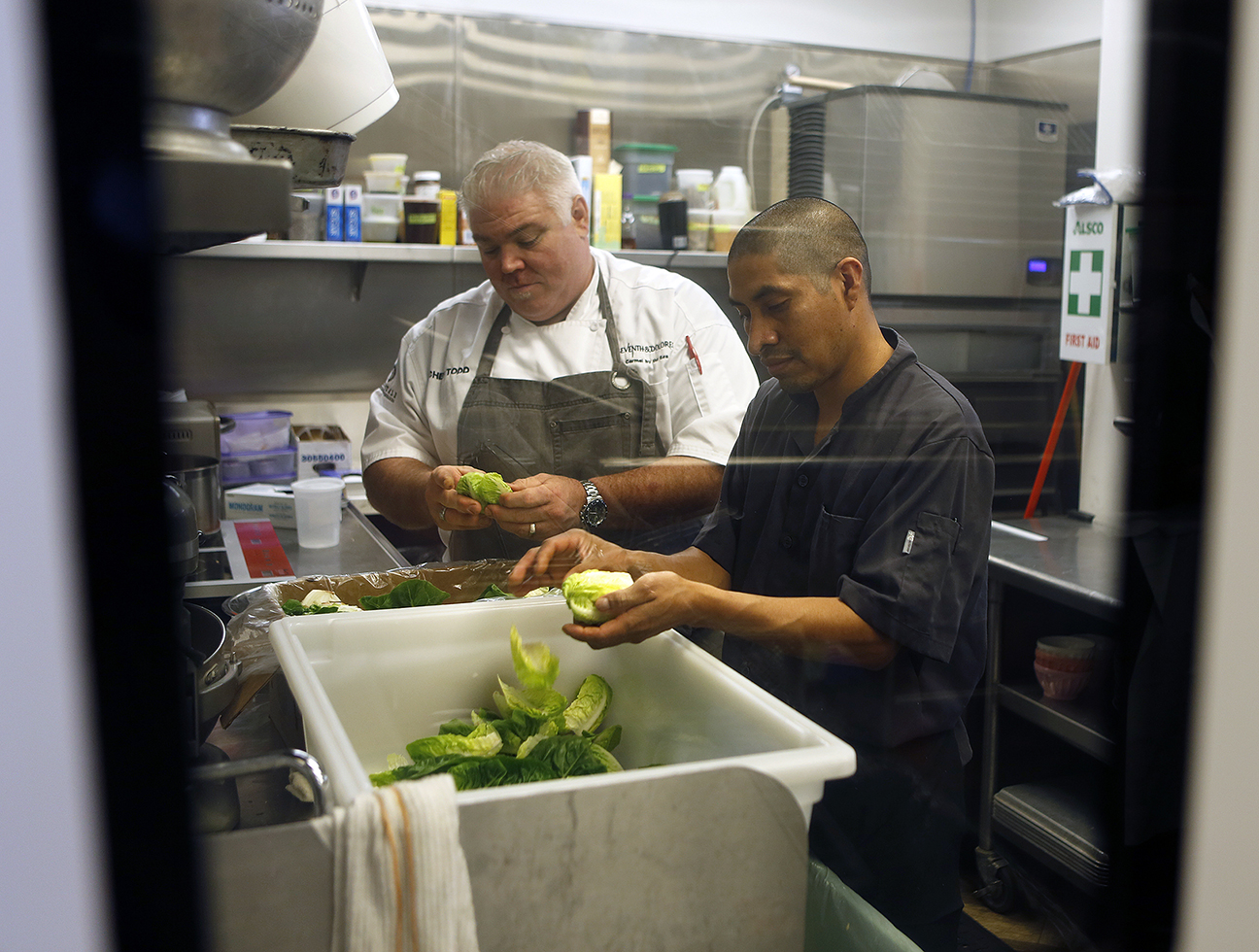By Mike Hale
Photographs by David Royal
Francisco Guzmán knows he drives like his abuela — slowly, overly cautious, hands at 10 and 2, with frequent peeks in his rear-view mirror.
The executive chef at a popular restaurant in Monterey County lives life in the slow lane because he cannot afford a ticket or the life that might follow if he is ever stopped by police.
Guzmán is not his real name. That is lost to history, erased the moment he crossed the border from Mexico. He was 16, in pursuit of life, liberty, happiness and a steady paycheck. He found them all inside that popular restaurant — washing dishes.
Seventeen years after his fateful crossing (on his third attempt) Guzmán is still undocumented, and he believes a traffic ticket could very well unravel what many consider a true American success story. It could send the married father of two — and now the boss of a kitchen crew that faces similar challenges — back across the border. Alone.
Like many others in his situation, Guzmán lives in fear, so much so that a few years ago he gave his children a sealed envelope “just in case I don’t come home.” Inside the envelope are instructions detailing their lives without him.
“It’s something I just have to deal with,” he said. “It is difficult how we live, sad actually. I just try to be better every day and be successful, no tickets, pay my taxes. My kids are doing well in school, in sports. It’s one of those things, and it got worse last year.”
Guzmán refers to the current administration’s stance on undocumented immigrants, a federal policy with repercussions for the American workforce — especially in the ag and restaurant industries.

There is no dearth of executive chefs like Guzmán — the creative forces behind restaurants — or even sous chefs, the top chef’s right hand. According to the National Restaurant Association, approximately 45 percent of the chefs working in U.S. restaurants are foreign-born. And a Pew Research study in 2014 found that more than 1.1 million undocumented immigrants work in restaurants.
The agriculture industry has been high profile in promoting the challenges it faces to maintain a dependable workforce during the past year due to heightened concerns about immigration raids. But representatives in the hospitality industry indicate they are facing similar issues. And in Monterey and Santa Cruz counties, where the principal economic drivers include both farming and tourism, which together generate approximately $8 billion annually, the hardships are exacerbated by the high cost of housing.
The current labor shortage in restaurants involves prep cooks, line cooks and dishwashers, and it affects every restaurant, from mom-and-pop joints to high-end, white tablecloth destinations.
“Never seen it like this,” said Guzmán. “It’s a crisis.”

Restaurants have long employed Mexican-Americans and immigrants from Mexico — and it’s been a delicious match.
“They are the backbone,” said Todd Fisher, executive chef at Seventh & Dolores in Carmel. “But lately we can’t seem to find qualified people to fill positions. We had four (applicants) last week who didn’t even show up for their interview.”
Fisher said his restaurant requires all applicants to upload their documents online. “It scares some of them off, I think, because they believe once they’re in the computer they will be reported if they are undocumented, or maybe they have fake paperwork, we don’t know.”
Passionfish chef-owner Ted Walter said immigration concerns remain the biggest factor in the shrinking talent pool. He traces it back to President Obama’s first term.
“Obama pumped up the deportation program, and Trump is continuing that,” he said. “But now the fear has gone up tremendously.”
Qualified cooks and dishwashers have all but disappeared, and in response local restaurants have lowered their standards while raising pay.
Current applicants have weaker skills, Fisher said, and cooks with just a few years experience are applying for jobs better suited to those with a decade or more on the line.

For some restaurants, it has begun to affect the quality of the food, forcing executive chefs to train on the fly, and sometimes even to simplify dishes. Yet they have no choice but to raise starting salaries.
“We pay dishwashers $14 an hour ($3 above minimum wage) to offset (the shortage),” Fisher said. “To be honest, it’s the most integral position. If you can’t put food on a clean plate you have nothing to sell. And if the dishes pile up the whole process breaks down.”
It’s also the dirtiest, most grueling job. “The sink is always full, and in downtime you may have to peel a 50-pound sack of potatoes,” Fisher said. “Then back to the hot sink to get stabbed by a dirty steak knife.”
In his first 35 years running restaurants, Walter hardly gave a second thought to his dishwashers. Now he goes through a new one every week or so.
“We finally found somebody and he goes out back to empty the garbage and never comes back,” Walter said. “That’s happened more than once.”
The result? Walter pitches in scrubbing pots, or his cooks are pressed into duty peeling potatoes, and a domino effect begins to decay the carefully calculated workflow.

Finding qualified line cooks — those who perform the demanding and often-dangerous culinary tasks under pressure and in hot, humid conditions — is equally challenging. Beyond the immigration issue, local chefs and restaurant owners have identified other contributing factors to the labor shortage:
• Pay disparity
Except for the top-tiered positions, the back-of-house employees are the lowest-paid at independent restaurants. The reasons? The National Restaurant Association claims the median profit margin for restaurants with average checks of $25 or more is a mere 4.5 percent. To keep labor costs in check, restaurant owners could always keep kitchen salaries in check because candidates were lining up around the block. But today a growing pay disparity between the kitchen crew and front-of-house workers has made cooking jobs less desirable.
California law requires restaurant tips to be shared only among employees who deal directly with diners. This creates a situation where servers often make two to three times more than a cook. In fact, it’s not uncommon for a good server at a fine-dining restaurant on the Monterey Peninsula to take home $80,000 or more a year.
Some big-city restaurants have created workarounds, having cooks run food out to tables (to qualify them for tips), or even creating a separate service fee line on the check, expressly for back-of-house workers.
But it’s not enough to stop the receding tide of labor.
• Cost of living
According to the Living Wage Calculator, a metric created in 2004 by MIT, a living wage for two adults (one working) with one child in Monterey County is $25.59 an hour, or roughly $53,000 per year. Currently the median salary for a restaurant cook is $24,323.
The numbers do not add up.
Seventh & Dolores cook Jesse García, 31, lives with his mother and little brother in Monterey. He works the line at the lively Carmel steakhouse Sunday through Thursday, following his daytime shifts at Tilly Gort’s in Pacific Grove. On his “days off” he works as a roofer.
“Most guys have other jobs,” said García, whose bare arms reveal old scars, cuts and burns, badges of honor, he said, from life in a restaurant kitchen. “Either you love it or hate it. I enjoy cooking.”
García’s line mate Eduardo Pérez, 23, lives with his parents in Greenfield, working at a Salinas pizzeria during the day before driving to Carmel. “I feel it in my knees sometimes, being on my feet all day,” said Pérez, who wants nothing more than to attend college and own an automotive-related business. “I love cars,” he said.
• Industry growth
Buoyed by America’s crazed food culture, the restaurant industry has actually experienced explosive growth over the last decade. That creates more jobs needing to be filled within a shrinking workforce.
“There are so many restaurants, new ones every week it seems,” Fisher said, “and only so many qualified candidates.”
The public’s appetite for new culinary adventures, diverse cuisine and Instagram moments shows no signs of waning. And with a surging economy, more and more restaurants will open.
But who will cook all the food? Not many immigrants, it seems, and certainly not many women.
• Not so female friendly
Anthony Bourdain’s 2000 lurid tell-all book “Kitchen Confidential” described restaurant kitchens as a “testosterone-fueled boy’s club.” Not unlike the sectors of politics and finance, restaurants have long been dominated by men. Bullying, unwanted sexual advances and gender inequality all have been normal operating procedures.
Today, much-needed change is afoot, led by the #metoo movement and several high-profile cases that saw celebrity chefs such as Mario Batali getting the ax for sexual harassment.
The bottom line: More than half of the population is female, yet only a scant percentage of women hold down restaurant kitchen jobs.
“The industry is changing, slowly, but overall it’s still not very friendly for women,” Fisher said. “The culture in my kitchen is respectful to all. We help each other and work as a team.”
Walter recently hired three women, one line cook and two dishwashers, but none lasted. “I love to hire women, but not many apply,” he said.
• Entitlement
It’s difficult to retain kitchen employees long-term, and many restaurateurs say that’s due to a general lack of work ethic and a sense of entitlement.You can blame television, they say, where a cook’s life appears so glamorous.
“Some of them don’t realize how hard it is,” said Guzmán, who often doesn’t witness the same level of commitment to the job he felt as a young man.
Chefs complain that many of today’s kitchen employees feel too entitled. They have Food Network delusions of grandeur and want to cook above their skill level. They want weekends off, they call in sick routinely, or sometimes they don’t show up at all.
But Guzmán recognizes the need to develop relationships with his crew, and his management style has evolved. It has to. In the end, he’s trying to save an industry that once saved him.
“What I’m trying to do with my employees is take care of them,” he said. “I check in. ‘How are you doing? What can I do for you? Is everything OK with your life? Are you happy here working with me?’”
He wants them to know they are needed, and valued.
At the end of the day, he said, “we’re all just people trying to make it work. So let’s have a beer together and talk like family.”

Have something to say about this story? Send us a letter.
Letters: David Binz: Restaurant Work Requires Talent, Dedication
Maria Rose Randazzo: Legal Residents Don’t Value Work Ethic
Adrian Foster: Immigration Story Did Not Answer Questions